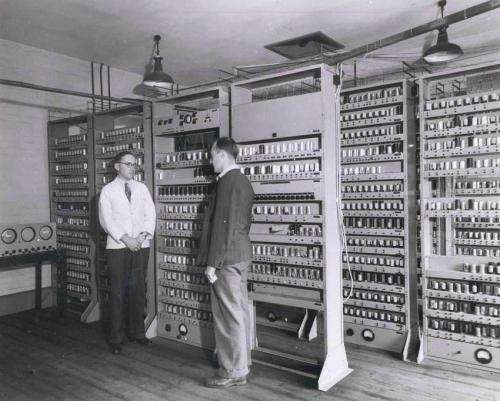December 13, 2015 weblog
Making progress in sheds and attics to rebuild EDSAC

In the UK, a group of engineers have been dedicating time in reconstructing the Electronic Delay Storage Automatic Calculator (EDSAC) and its past and present requirements to do so amount to quite a challenge.
Volunteers have been stepping up to help out the in this rebuild and the question is, why bother? The answer is linked to the goals of those reconstructing this computer. The goal is that EDSAC be a living exhibit at The National Museum of Computing. It will be used to help teach schoolchildren about programming.
It dates back, after all, to 1949. Designed by Sir Maurice Wilkes, EDSAC ran in 1949, to serve scientists at the University of Cambridge. They now had a tool, said the BBC, that could crunch numbers faster than they could using hand-based calculation methods.
Wilkes turned to construction materials based on his own exposure to electronics and valves when he did wartime work on radar, and to mercury delay lines it used for memory, said one of the veterans who are reconstructing the computer, James Barr.
Barr studied at Cambridge during the 1970s, said the BBC, and was lectured by many of the men who built EDSAC including Wilkes.
I Programmer said after Cambridge, Barr was a programmer, project manager and analyst until his retirement in 2012. He heard about the EDSAC initiative and did a makeover of his garden shed into "Edshack." This has become just one of several home workshops across England playing a role in EDSAC reconstruction.
Barr's present work, said I Programmer, requires a knowledge of thermionic valves or tubes that were used for war-time RADAR and preceded the invention of transistors and silicon chips.
Wilkes' designs have been largely lost. The BBC said that even if they could be found, that might not have helped because the machine changed as it was being built. That, said Barr, left the EDSAC reconstruction project with a big problem. Namely, they did not have a clear idea of how the thing was wired up, said the BBC.
The BBC report tells the story of how uphill a task it has been to reconstruct this computer. Point made, for example: Each of the 140 "chassis" that form EDSAC takes upwards of 20 hours to build and test. Barr said it takes 20 to 40 man hours per chassis but here's the rub: "This wiring work is so mentally draining that Barr and his fellow volunteers can only work on a chassis for a couple of hours at a time."
The team first worked with pictures of the computer, studying the valves' layout, figuring out how they formed the logic for computation. The team tried to work how its 3,000 valves were laid out and how they formed the logic that lent the machine its computational power. Success: Some EDSAC plans were discovered. The 19 detailed diagrams were sitting in a corridor pile destined for the scrap heap before being discovered, rescued, and handed over to the project team, trying to get in tune with the EDSAC engineers' thinking.
On Saturday, Sue Gee in I Programmer offered more on where EDSAC's team members stand so far.
She quoted Barr talking about this: "We are trying to stick to the traditional language that was in use at the time. Wilkes referred to them as 'orders', the modern terminology is instructions. The order coding chassis deal with the fact that in the memory of the computer instructions are coded as a number consisting of 5-bits."
Latest progress summary: About 60 percent of the chassis have now been finished, said Barr, and that means the project can move on to its next phase, getting all those separate parts to work together."
Dr. Andrew Herbert, overall project manager for the EDSAC reconstruction said they were finding "all the classic integration problems. Different parts of the machine are expecting things at different voltages and times."
Herbert also said in the BBC story: "By early spring we will able to demonstrate fetching a number out of the store, giving it to the accumulator, adding one to it and then sending it back."
The BBC remarked that might trivial "but it is the basis of all machine-based computation. Getting that working will be a strong signal that the whole project is on the right track and that the machine will be recreated successfully."
What next—"We hope we will have a working machine by the summer next year," said Herbert. "We are not counting our chickens yet but they are at least heading towards the hen house."
© 2015 Tech Xplore



















